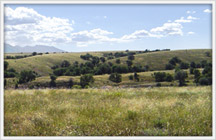Rangeland Hydrology and Erosion Model Web Tool
The RHEM Web Tool

The RHEM Web Tool is a web-based interface for the Rangeland Hydrology and Erosion Model (RHEM). The interface allows users to input commonly known rangeland characteristics and use parameter estimation equations to construct model input files and run the RHEM model.
This web application was built with the following goals in mind:
- Simplify the use of RHEM
- Manage user sessions
- Centralize scenario results (model runs)
- Compare scenario results
- Provide tabular and graphical reports
The RHEM Model

RHEM is designed to provide sound, science-based technology to model and predict runoff and erosion rates on rangelands and to assist in assessing rangeland conservation practice effects. RHEM is a newly conceptualized, process-based erosion prediction tool specific for rangeland application, based on fundamentals of infiltration, hydrology, plant science, hydraulics and erosion mechanics.
Built with:
Version: 2.4 Update 1
- New climate stations panel to select international stations by continent
- Clip long climate station names in the scenario tables (comparison and risk assessment tables)
- Allow users to share scenarios
- Help documentation updates
- All scenario runs now being done via CSIP Web Services
Version: 2.4
- New CLIGrid funtionality
- New International Climate Stations
- Scenario comparison report updates
- Risk assessment report updates
- Updates to Ke equations
- RHEM batch script updates
Version: 2.3 Update 5
- Added a new checkbox and SAR input box to the Soil Texture panel for saline scanarios.
- When a scenario is ran with this SAR value, a new row will appear in the Annual Averages table showing the "Salt Load".
Version: 2.3 Update 4
- Ability to export report graphics as SVG.
- Added a "Yearly Totals" table to the return period table when running single scenarios.
- Added ability to define the order of the scenarios when running a scenario comparison.
- Metric units in the output reports have been changed from tonne/ha to Mg/ha (4-3-2019)
Version: 2.3 Update 3
- International climate stations are now supported. Users can submit CLIGEN .PAR files (with station statistics) to create a new climate station.
- Slope length is defaulted to 50m (164ft). The slope length input box in the "Slope" panel has been removed.
Version: 2.3 Update 2
- Slope length is now default to 50m (164ft).
- The input parameter modification tool now allows the user to modify the LEN parameter (slope length).
- Application has been scaled up allowing scenarios to run about 40% faster.
Version: 2.3 Update 1
- This update provides a risk assessment (probability-based) approach to natural rangeland conditions erosion modeling, and provides the frequency of occurrence for each alternative scenario based on annual soil loss return levels.
Version: 2.3
- New set of parameter estimation equations were developed to estimate the splash and sheet erodibility coefficient on natural rangeland conditions
- Improvement to the rainfall disaggregation algorithm
- In general, you may find that RHEM version 2.3 produces greater soil loss predictions than the previous version
Version: 2.2
- New set of parameter estimation equations were developed for the Smith-Parlange infiltration equation
- Minor adjustment done to the splash and sheet erodibility parameter estimation equation (11) and (12) described in Nearing et al. 2011 to account for an improved calibration factor and for better representing slope steepness
- Erodibility coefficient Kω has been slightly increased to better represent concentrated flow erosion in undisturbed rangelands
- Model version used to run scenarios can be seen in the scenarios listing
Version: 2.1
- Multiply Kss for all cases by 1.3 in order to account for the bias in the log transformation (relative to Duan 1989)
- Ability to rename scenarios through the scenarios list by clicking on scenario name
- A graphical (PNG) report can be created from a scenario comparison
- User account section added to control detailed output reports and manual input file modifications
Version: 2.0
A prototype next-generation version (version 2) of the Rangeland Decision Support System (RHEM) is under development.
Version: 1.2
Updated Kc and Tc.
Version: 1.1
Updated model equations.
Version: 1.0
News
